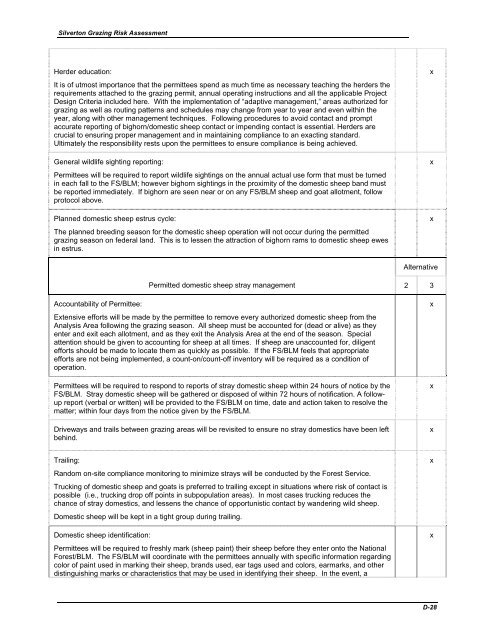NEPA--Environmental Assessment
NEPA--Environmental Assessment
NEPA--Environmental Assessment
You also want an ePaper? Increase the reach of your titles
YUMPU automatically turns print PDFs into web optimized ePapers that Google loves.
Silverton Grazing Risk <strong>Assessment</strong><br />
Herder education:<br />
It is of utmost importance that the permittees spend as much time as necessary teaching the herders the<br />
requirements attached to the grazing permit, annual operating instructions and all the applicable Project<br />
Design Criteria included here. With the implementation of “adaptive management,” areas authorized for<br />
grazing as well as routing patterns and schedules may change from year to year and even within the<br />
year, along with other management techniques. Following procedures to avoid contact and prompt<br />
accurate reporting of bighorn/domestic sheep contact or impending contact is essential. Herders are<br />
crucial to ensuring proper management and in maintaining compliance to an exacting standard.<br />
Ultimately the responsibility rests upon the permittees to ensure compliance is being achieved.<br />
General wildlife sighting reporting:<br />
Permittees will be required to report wildlife sightings on the annual actual use form that must be turned<br />
in each fall to the FS/BLM; however bighorn sightings in the proximity of the domestic sheep band must<br />
be reported immediately. If bighorn are seen near or on any FS/BLM sheep and goat allotment, follow<br />
protocol above.<br />
Planned domestic sheep estrus cycle:<br />
The planned breeding season for the domestic sheep operation will not occur during the permitted<br />
grazing season on federal land. This is to lessen the attraction of bighorn rams to domestic sheep ewes<br />
in estrus.<br />
Accountability of Permittee:<br />
x<br />
x<br />
x<br />
Alternative<br />
Permitted domestic sheep stray management 2 3<br />
Extensive efforts will be made by the permittee to remove every authorized domestic sheep from the<br />
Analysis Area following the grazing season. All sheep must be accounted for (dead or alive) as they<br />
enter and exit each allotment, and as they exit the Analysis Area at the end of the season. Special<br />
attention should be given to accounting for sheep at all times. If sheep are unaccounted for, diligent<br />
efforts should be made to locate them as quickly as possible. If the FS/BLM feels that appropriate<br />
efforts are not being implemented, a count-on/count-off inventory will be required as a condition of<br />
operation.<br />
Permittees will be required to respond to reports of stray domestic sheep within 24 hours of notice by the<br />
FS/BLM. Stray domestic sheep will be gathered or disposed of within 72 hours of notification. A followup<br />
report (verbal or written) will be provided to the FS/BLM on time, date and action taken to resolve the<br />
matter; within four days from the notice given by the FS/BLM.<br />
Driveways and trails between grazing areas will be revisited to ensure no stray domestics have been left<br />
behind.<br />
Trailing:<br />
Random on-site compliance monitoring to minimize strays will be conducted by the Forest Service.<br />
Trucking of domestic sheep and goats is preferred to trailing except in situations where risk of contact is<br />
possible (i.e., trucking drop off points in subpopulation areas). In most cases trucking reduces the<br />
chance of stray domestics, and lessens the chance of opportunistic contact by wandering wild sheep.<br />
Domestic sheep will be kept in a tight group during trailing.<br />
Domestic sheep identification:<br />
Permittees will be required to freshly mark (sheep paint) their sheep before they enter onto the National<br />
Forest/BLM. The FS/BLM will coordinate with the permittees annually with specific information regarding<br />
color of paint used in marking their sheep, brands used, ear tags used and colors, earmarks, and other<br />
distinguishing marks or characteristics that may be used in identifying their sheep. In the event, a<br />
x<br />
x<br />
x<br />
x<br />
x<br />
D-28

















